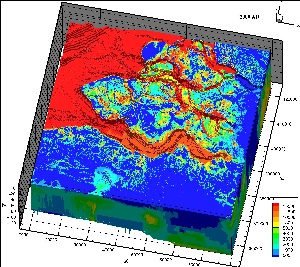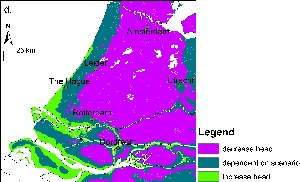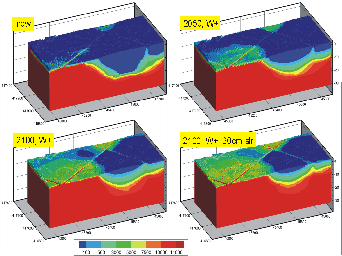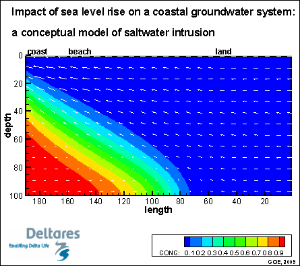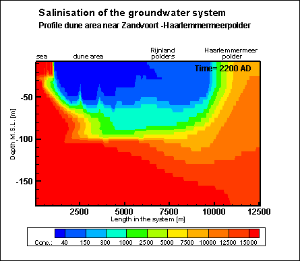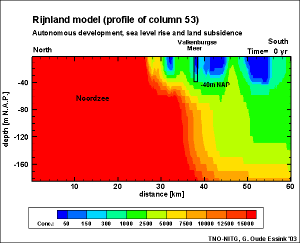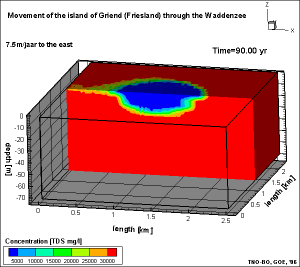| Type | Project | |
|---|---|---|
National | Netherlands Hydrological modelling Instrument (NHI)The so-called Netherlands Hydrological modelling Instrument (NHI) includes a module to take into account fresh and saline groundwater in the coastal zone. This paper informs you about this NHI fresh-saline groundwater module, which assesses on a national scale the impact of stresses such as sea level rise, land subsidence, increasing groundwater extraction and changes in natural groundwater recharge on groundwater in the Dutch coastal zone. Modelling results show that the water system significantly becomes more saline these coming 50-100 years, and that water courses need to be flushed more intensively if water boards want to maintain the water quality in the surface water system. This module is ready to play a role in assessing the effectiveness of mitigation and adaptation strategies to make our water system climate proof. Article: De Lange, W.J., Prinsen, G.F., Hoogewoud, J.C., Veldhuizen, A., Verkaik, J., Oude Essink, G.H.P., van Walsum, P.E.V., Delsman, J.R., Hunink, J.C., Massop, H.T.L., Kroon, T., 2014. An operational, multi-scale, multi-model system for consensus-based, integrated water management and policy analysis: The Netherlands Hydrological Instrument. Environmental Modelling & Software 59, 98–108, doi: 10.1016/j.envsoft.2014.05.009 More information: Jarno Verkaik, Joost Delsman or Gualbert Oude Essink | |
| Regional | Research on salinisation processes in the Province of ZeelandThe fresh water resources in the groundwater system of the coastal province of Zeeland are at present jeopardized by various causes. Floods, droughts, eutrophication and salinisation of the ground and surface waters are some pressing topics. Moreover, sea level rise and climate change threaten the groundwater system even more. Water management in the province should anticipate on these changes. The province has initiated a study to get a better insight in the salinisation processes in the top system. The main goal is to analyse what measurements are effective in mitigating the salinisation of the water system. Special attention is given to the so-called rainwater lenses in agriculture plots. Agricultural crops depend on these shallow vulnerable water systems which float upon brackish groundwater and vary over the season in thickness. Poster Salt Water Intrusion Meeting 2010 (Engels): poster | |
| Regional | Research on salinisation processes in the Province of Zuid-HollandLarge parts of the Province Zuid-Holland, the Netherlands, are situated several metres below mean sea level. Saline groundwater from the North Sea and from deep marine fine-grained deposits intrudes the upper aquifers. Natural processes and anthropogenic events of land surface settling, that have been going on for nearly a millennium, cause the salinisation of the subsoil. In addition, future sea level rise and land subsidence are expected to jeopardise the groundwater system even more. Water managers are concerned about the future state of this dynamic groundwater system during the coming 100 years. A 3-dimensional model was constructed to quantify changes in the groundwater system. The model predicts that past land subsidence and sea level rise lead to an accelerated inflow of saline groundwater towards the coastal groundwater system in the next centuries. Article: Oude Essink, G.H.P., E.S. van Baaren, and P.G.B. de Louw. 2010. Effects of climate change on coastal groundwater systems: A modeling study in the Netherlands, Water Resour. Res., 46, W00F04, doi: 10.1029/2009WR008719. Presentation:: Oude Essink G.H.P, Van Baaren E.S., De Louw P.G.B., 2010, Effects climate change on coastal groundwater systems, focus on the Rhine Delta, Proceedings Deltas in Times of Climate Change, Rotterdam, The Netherlands, Sept-Oct. 2010 download | |
| Local | Local phenomena: saline boils and rainwater lensesSaline boilsLouw, P.G.B., de, van der Velde, Y., and van der Zee, S.E.A.T.M. 2011. Quantifying water and salt fluxes in a lowland polder catchment dominated by boil seepage: a probabilistic end-member mixing approach, Hydrol. Earth Syst. Sci., 15, 2101-2117 Louw, P.G.B., de, Oude Essink, G.H.P., Stuyfzand, P.J., Zee, van der, S.E.A.T.M., 2010, Upward groundwater flow in boils as the dominant mechanism of salinization in deep polders, The Netherlands, J. Hydrol. 394, 494-506. Shallow rainwater lensesLouw, P.G.B., de, Eeman, S., Siemon, B., Voortman, B.R., Gunnink, J., van Baaren, E.S., and Oude Essink, G.H.P., 2011, Shallow rainwater lenses in deltaic areas with saline seepage, Hydrol. Earth Syst. Sci., 15, 3659-3678. | |
|
Peer-reviewed articles fresh-saline modelling
Faneca Sànchez, M., Gunnink, J., van Baaren, E.S., Oude Essink, G.H.P., Elderhorst, W., de Louw, P.G.B., Siemon, B., Auken, E. 2012. Modelling climate change effects on a Dutch coastal groundwater system using airborne Electro Magnetic measurements, Hydrol. Earth Syst. Sci., 16, 4499-4516, doi:10.5194/hess-16-4499-2012.
link to HESS
Pauw, P.S., Louw, P.G.B., de, Oude Essink, G.H.P. 2012. Groundwater salinization in the Wadden Sea area of the Netherlands; quantifying the effects of climate change, sea level rise and anthropogenic interferences, Netherlands Journal of Geosciences 91-3, 373-383.
link to NJG
Oude Essink, G.H.P. and Kooi, H. 2012. Land-subsidence and sea-level rise threaten fresh water resources in the coastal groundwater system of the Rijnland water board, The Netherlands, p. 227-248, Chapter 13 in: Climate Change Effects on Groundwater Resources: A Global Synthesis of Findings and Recommendations, Treidel, H., Martin-Bordes, J.L. and Gurdak, J.J. (Eds), 401 p.
link to Book
Oude Essink, G.H.P., E.S. van Baaren, and P.G.B. de Louw 2010, Effects of climate change on coastal groundwater systems: A modeling study in the Netherlands, Water Resour. Res., 46, W00F04, doi:10.1029/2009WR008719.
download
Oude Essink, G.H.P. 2001. Salt Water Intrusion in a Three-dimensional Groundwater System in The Netherlands: a Numerical Study, Transport in Porous Media 43(1): 137-158, doi: 10.1023/A:1010625913251
download
Oude Essink, G.H.P. 2001. Saltwater intrusion in 3D large-scale aquifers: a Dutch case, Phys. & Chem. of the Earth 26(4): 337-344, doi: 10.1016/S1464-1909(01)00016-8
download
User Manuel MOCDENS3D
Vandenbohede, A. 2008, Ghent University, Visual MOCDENS3D: Visualisation and processsing software for MOCDENS3D, a 3D density dependent groundwater flow and solute transport model.
download
Reports, proceedings 3D fresh-saline modelling
Oude Essink, G.H.P. 2001. Density dependent groundwater flow at the island of Texel, The Netherlands. Proc. 16th Salt Water Intrusion Meeting, Miedzyzdroje-Wolin Island, Poland: 47-54.
download
Oude Essink, G.H.P. 1999. Simulating 3D density dependent groundwater flow: the adapted MOC3D. Proc. 15th Salt Water Intrusion Meeting, Ghent, Belgium: 69-79.
download
Oude Essink, G.H.P. 1998. MOC3D adapted to simulate 3D density-dependent groundwater flow. In: Proc.MODFLOW'98 Conference, October 4-8, 1998, Golden, Colorado, USA, Vol. I, 291-303.
download
Animations: examples
Download:
Henry's profile with sea level rise
Download:
Dutch profile with extraction, upconing and low inland levels
Download:
Profile over 3D model: autonomous salinisation, sea level rise
Download:
The movement of island De Griend (The Netherlands) and the creation of the freshwater lens
Download:
Evolution of a freshwater lens
Reports, proceedings on the effect of Climate Change on groundwater resources
Oude Essink, G.H.P. 2001. Density dependent groundwater flow at the island of Texel, The Netherlands. Proc. 16th Salt Water Intrusion Meeting, Miedzyzdroje-Wolin Island, Poland: 47-54.
download


